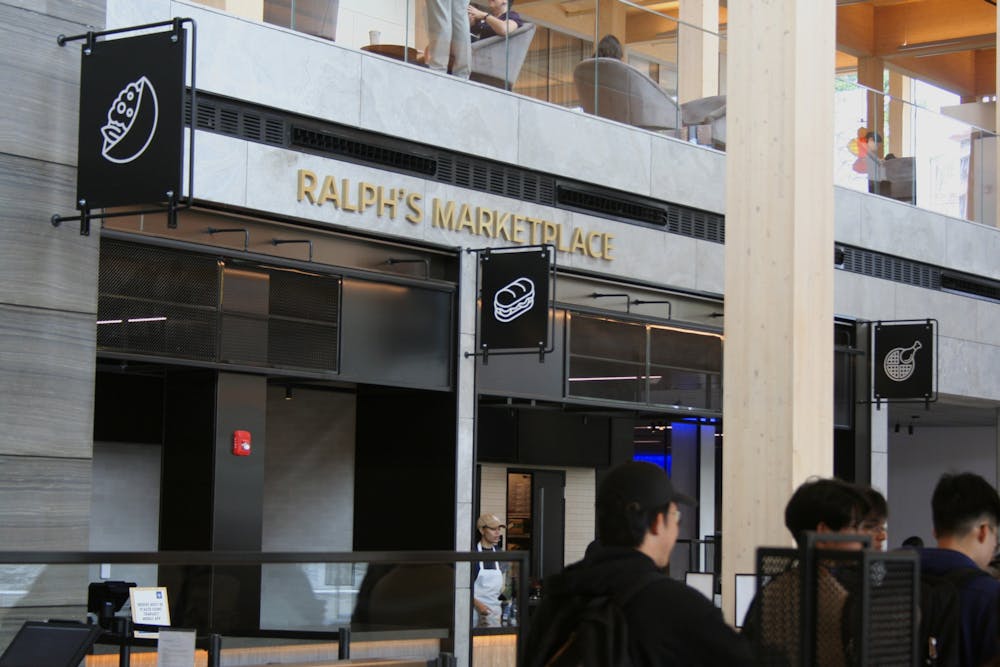The Grand Opening of the Bloomberg Student Center dining options occurred on Monday, Oct. 6, 2025. Consisting of food choices such as Koshary Corner, Connie’s Chicken and Waffles, Tim Ma Hospitality and the Urban Oyster, the launch marked a new era of on-campus dining options.
As such, The News-Letter has continued to examine how the addition of the Student Center has influenced student life, campus culture and the overall sense of community at Hopkins.
The grand opening celebration
The grand opening celebration of the Student Center took place on Oct. 16, with donors filling the Student Center to celebrate its completion. The event opened with a short performance and skit from the Hopkins Pep Band, Peabody musicians and Hopkins students, followed by opening remarks from President Ronald J. Daniels. Daniels outlined the history of the Student Center, beginning with its original conception in 1884.
In the official press release for the opening of the Student Center, the University described the building as a cornerstone for student engagement and collaboration.
“The new facility will serve as a new hub for campus life, connecting members of the Hopkins community to one another from across different campuses, backgrounds, interested [and academic] pursuits,” the University wrote. “Designed to emphasize openness, the Student Center’s rooms and event facilities are flexible and shared by all, with no permanently assigned spaces.”

JOSEPH GREGORY / STAFF PHOTOGRAPHER
Donors and Hopkins affiliates gathered on Oct. 16 to celebrate the grand opening of the Bloomberg Student Center.
A short speech by Michael Bloomberg followed Daniels’ opening, highlighting the University’s contributions to democracy and public health. He also reflected on his long-standing relationship with Hopkins and the importance of giving back to the institution that shaped his career.
“[When] I graduated, I sent the University a check for five dollars. It wasn’t much, but the dollar amount didn’t matter. The most important thing is that I recognized that I owed something [to Hopkins] and I would owe it for the rest of my life,” he said. “I’ve been fortunate enough to help students attend Hopkins, regardless of their family income.”
Following the ceremony and remarks from University leaders, attention shifted to how students have been engaging with the newly opened facilities.
One student, senior Tanti Felli, was tasked with presenting at the grand opening on behalf of the Office of Leadership Engagement and Experiential Development (LEED). He shared his perspective on the importance of student leadership and representation within the athletic community in an interview with The News-Letter.
“We’re here trying to show the Student Life Committee how important leadership is, not only for the athletic community, but for Hopkins as a whole,” he said. “I’ll be presenting with two other athletes. I feel like our involvement with the leadership space in the athletic community has been pretty prominent, so I feel like that’s why we’re invited.”
Atmosphere
The News-Letter conducted a survey measuring student response to the Student Center after the opening of the dining options to gauge changes in community attitude. Overall, students rated the atmosphere of the Student Center an average of 7.67 on a scale of one to 10, 0.67 higher than the rating of the atmosphere before the dining options opened.
Similarly, students rated their ability to socialize and connect with others in the Student Center an average of 7.13 on a scale of one to 10, 1.57 higher than the rating before dining options opened. Together, these scores indicate that the addition of dining spaces has enhanced the social environment of the Student Center but did little to change its overall atmosphere.
These results suggest that while students appreciate the new dining options for their ability to bring people together, the ambiance and functionality of the Student Center remain largely consistent with previous perceptions.
Senior Grace Aboagye reflected on this shift, sharing her observations in an interview with The News-Letter.
“People [have] become more social as they go downstairs, because they have to use the mobile app to order,” she said. “So they order, and while they’re waiting around for their order, that gives them a chance to converse, to talk. I’ve seen that a lot in recent weeks.”
Moreover, she noted that the dining additions have made the space feel more dynamic and community-oriented, giving students a reason to linger and interact beyond academic or club-related activities.
“It’s a cool space,” Aboagye said. “I feel like maybe I expected something a little different, considering how long it took to make it, I feel like there might have been a chance for more fun spaces, but I think that what they do have is pretty cool.”
Likewise, sophomore Suryan Plenz mirrored this response in an email to The News-Letter. He explained that the introduction of dining options has transformed the Student Center into a more inviting and social environment.
“It’s so much more lively than before. One way [that] everyone bonds is through food. Before, the Stuce was just some big building with places to study, now it has a small food court,” he wrote. “I’ve been going to the Stuce a lot more. Lowkey every day now.”
Quality of dining options
As students begin to utilize the Student Center in different ways, survey data reveal varying levels of engagement with its dining options.
The News-Letter’s survey found that 36.7% of students never indulge in the food options at the Student Center, 60% reported eating there one to three days a week and only 3.3% of students partook in dining 4–6 days a week. This suggests that while the Student Center has generated interest, regular use remains limited among much of the student body.
Generally, students found that the quality of food was satisfactory, though not exceptional. Many students noted that while the new options added variety, the taste and portion sizes could be improved.
The survey found that students rated the food quality an average of 6.9 on a scale of one to 10. This statistic was generally even, with 36.6% of students rating the quality between one and six, while 63.3% of students rated the quality between seven and 10.
In an interview with The News-Letter, senior Biomedical Engineering major Taliyah Huang shared her experience trying one of the new menu items.
“I’ve tried the burger, and I was recommended it by my friend because he said that it was really worth the value — it was only 10 bucks or something, and it had plenty of food — so I decided to try [it] as well, and I was pretty satisfied with how it turned out,” Huang said. “[The Student Center] smells like food now. Other than that, I wouldn’t say a lot of people have been using the food options too much, so there hasn't been that big of a difference in my opinion.”
While some students like Huang appreciated the convenience and taste of the food options, others found the pricing to be a significant drawback.
Pricing of food
The topic of affordability was a recurring theme among survey responses. 80% of students reported that the pricing of the options was expensive, while 20% said the pricing was fair or affordable. This sentiment reflected broader concerns about accessibility and meal budgeting among students.
“The food price for a rice bowl is 12-14 dollars, yet the portion size is very small. I have only had food 1/2 times after the dining opened because it is expensive in the long run. We are students at the end of the day,” one anonymous responder wrote. “Whether we use dining dollars, J-Cash or a card, eating almost $15-20 worth of meals every day is not feasible.”
Additionally, students also pointed out the limited value and flexibility of meal options, noting that the overall pricing structure makes it difficult to enjoy a complete dining experience.
“Some meals are a little expensive, making it difficult to get the full meal typically offered at cafeterias (entrée + drink, side, dessert, etc.),” another responded. “For those who typically only eat the entrée, this setup ends up working out fine, but it can get expensive if one wants to have all of the options seen at other cafeterias.”
Accessibility to dietary needs
While pricing emerged as a major concern, many students emphasized that affordability is not the only barrier to dining at the Student Center. For example, accessibility for students with specific dietary needs also plays a significant role.
In an interview with The News-Letter, freshman Dhruva Lahoti discussed how his dietary restrictions affect his ability to enjoy the dining options.
“I went one time, and I’m vegetarian, so... all I’ve heard is that the chicken and waffles are pretty good. [...] But, when I got one thing, the portion size was kind of small,” he said. “They have a lot more options. As a freshman, I don’t have as many dining dollars [...] so I wouldn’t be able to eat [there] consistently.”
Lahoti’s concerns about dietary inclusivity were also echoed by several students, many of whom emphasized that while the addition of dining options has diversified the food scene on campus, it has not necessarily expanded accessibility for students with specific dietary needs. Several respondents noted that vegetarian, vegan, halal and allergy-friendly options remained limited or inconsistently available across vendors.
One anonymous responder raised concerns about the lack of halal-friendly options, underscoring how this issue can alienate students who follow specific dietary practices.
“The dining options are currently limited to just one halal choice. Aside from Koshary, I can't consume anything else, which is quite disappointing. There should ideally be at least one or two more halal options available,” they wrote. “Places like Urban Kitchen or Connie’s could easily incorporate halal chicken into their menus, as it costs the same as regular chicken. Johns Hopkins should have taken the initiative to talk to them about this.”
The responder then went on to emphasize the cultural and ethical importance of these dietary considerations.
“Moreover, halal chicken is often considered better for the body. We care about animals and want to minimize their suffering, and saying a prayer for them is a meaningful gesture,” they wrote. “Several research articles support this, and given that Johns Hopkins University is a leading research institution, it should consider these factors.”
Likewise, another respondent cited challenges related to food allergies and the mobile ordering system.
“I have a gluten allergy so I can't eat much there. The Koshary place has a great tasting bowl but there isn't a place to leave notes when you order so I can't leave a warning that I need to avoid cross-contamination,” they wrote. “Also, for example, I ordered the protein bowl one time and it apparently has dressing on it, but I don't like dressing... There needs to be a place to leave notes/comments on the mobile ordering app for reasons like those.”





